Injeolmi is a rice cake made from a mixture of glutinous rice powder and powdered soybeans. It's a type of chewy, sticky rice cake. Injeolmi is regularly served on the table at traditional weddings. It was also offered as one of the main wedding foods offered by the bride to the groom’s family, in a wish for the newlywed couple to live happily and closely, just like the sticky rice cakes are close together.
Injeolmi even fascinated a king once. During the reign of King Injo (1623-1649), the 16th king of the Joseon Dynasty, a man named Yi Gwal rose in rebellion and the king had to leave for Gongju from Hanyang, an old name for Seoul. When he arrived in Gongju, the king was hungry. One of his servants offered the king a bowl of rice cake covered with soybean powder, which was originally made by a commoner. The king loved the chewy, yet soft, texture and the taste. He asked for the name of the dish. The servant answered that he didn't know the name, but that it was originally made by a person with the surname of Im or Yim. So the king ordered that the food be called “imjeolmi" (任絶味), which means "rice cake made by a person named Yim." The name was later changed to today's injeolmi.
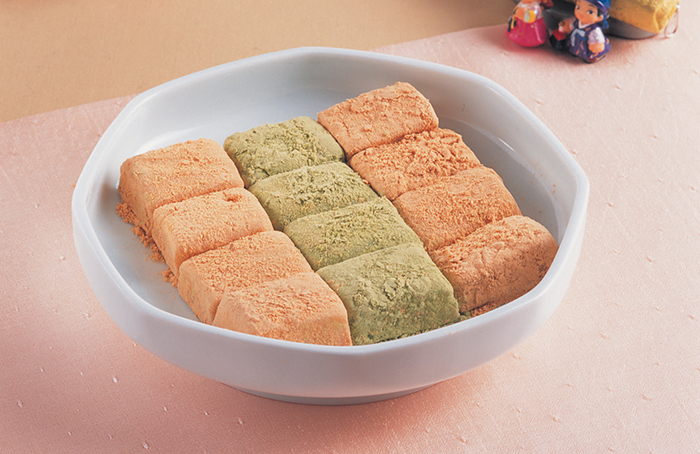
These days at traditional festivals we can see people trying to tteongme, which means to pound the steamed rice cake mixture with a giant mallet-shaped stick, also called a tteongme. This can be seen quite often just before traditional holidays or at special folk events. In fact, injeolmi pounded with a tteongme mallet is said to be much more delicious and chewier than sticky rice cake pounded with a jeolgu, a kitchen utensil used to pound rice cake dough.
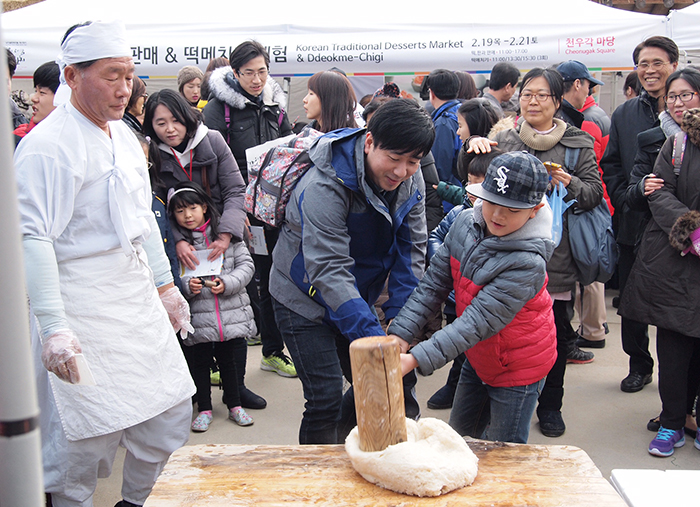
** Ingredients
3 cups powdered glutinous rice (300 grams)
0.75 teaspoons of salt (3 grams)
2-3 tablespoons of water (30-45 grams)
yellow soybean powder (20 grams)
green soybean powder (20 grams)
10 cups water for steaming (2 kilograms)
** Preparation
1. Add the salt to the glutinous rice powder. Air the mixed powder by using a strainer. Add the water and mix it well.
** Recipe
1. Put the water in a steamer and place it over high heat for about 9 minutes. When it boils, cover it with a wet cotton cloth and add the rice powder. Steam it for 15 minutes.
2. Pound the steamed mixture for 3 minutes.
3. Cut the pulverized dough in half. Sprinkle the yellow soybean powder over one half of the mixture. Sprinkle the green soybean powder over the other half. Shape each of the loaves of dough into a rectangular shape about 2 centimeters thick. Cut each loaf into 3 centimeter by 4 centimeter squares. Add more soybean powder to each of the rice cake squares.
Managed by Yoon Sojung
Korea.net Staff Writer
In cooperation with the Institute of Traditional Korean Food (ITKF)
Photos: ITKF, Namsangol Hanok Village
arete@korea.kr
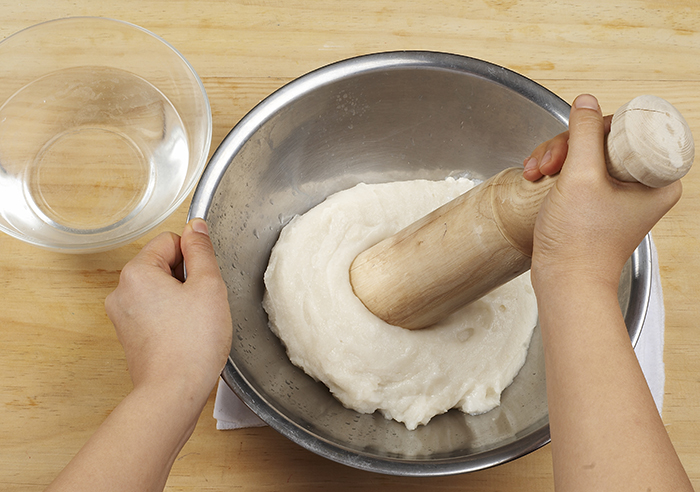
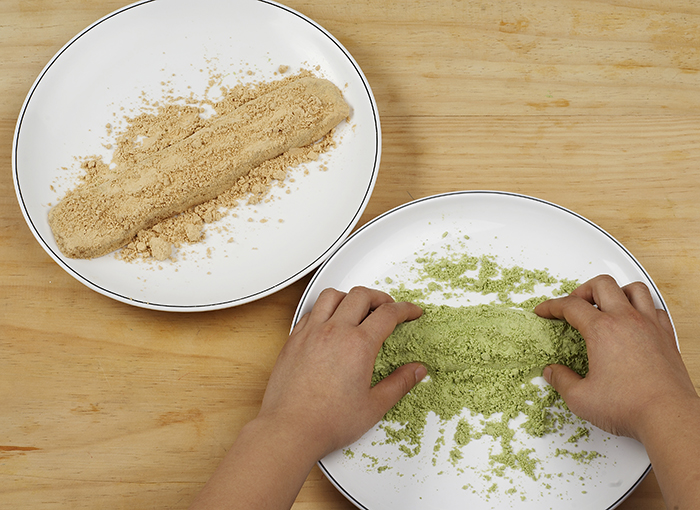
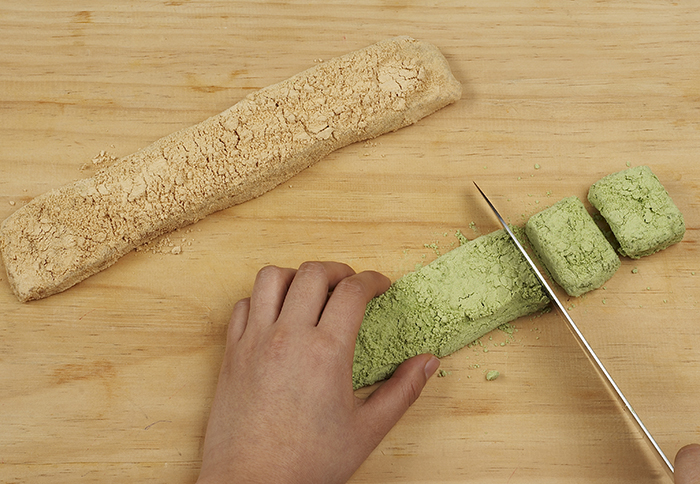
Injeolmi even fascinated a king once. During the reign of King Injo (1623-1649), the 16th king of the Joseon Dynasty, a man named Yi Gwal rose in rebellion and the king had to leave for Gongju from Hanyang, an old name for Seoul. When he arrived in Gongju, the king was hungry. One of his servants offered the king a bowl of rice cake covered with soybean powder, which was originally made by a commoner. The king loved the chewy, yet soft, texture and the taste. He asked for the name of the dish. The servant answered that he didn't know the name, but that it was originally made by a person with the surname of Im or Yim. So the king ordered that the food be called “imjeolmi" (任絶味), which means "rice cake made by a person named Yim." The name was later changed to today's injeolmi.

Injeolmi pounded rice cake is known for its chewy texture and soft taste.
These days at traditional festivals we can see people trying to tteongme, which means to pound the steamed rice cake mixture with a giant mallet-shaped stick, also called a tteongme. This can be seen quite often just before traditional holidays or at special folk events. In fact, injeolmi pounded with a tteongme mallet is said to be much more delicious and chewier than sticky rice cake pounded with a jeolgu, a kitchen utensil used to pound rice cake dough.

Festival-goers try their hand at pounding rice cake dough at the Namsangol Hanok Village in Seoul.
** Ingredients
3 cups powdered glutinous rice (300 grams)
0.75 teaspoons of salt (3 grams)
2-3 tablespoons of water (30-45 grams)
yellow soybean powder (20 grams)
green soybean powder (20 grams)
10 cups water for steaming (2 kilograms)
** Preparation
1. Add the salt to the glutinous rice powder. Air the mixed powder by using a strainer. Add the water and mix it well.
** Recipe
1. Put the water in a steamer and place it over high heat for about 9 minutes. When it boils, cover it with a wet cotton cloth and add the rice powder. Steam it for 15 minutes.
2. Pound the steamed mixture for 3 minutes.
3. Cut the pulverized dough in half. Sprinkle the yellow soybean powder over one half of the mixture. Sprinkle the green soybean powder over the other half. Shape each of the loaves of dough into a rectangular shape about 2 centimeters thick. Cut each loaf into 3 centimeter by 4 centimeter squares. Add more soybean powder to each of the rice cake squares.
Managed by Yoon Sojung
Korea.net Staff Writer
In cooperation with the Institute of Traditional Korean Food (ITKF)
Photos: ITKF, Namsangol Hanok Village
arete@korea.kr

Pound the steamed dough for 3 minutes. Soaked glutinous rice can also be used to make the mixture.

Cover each loaf of rice cake dough with a different color of soybean powder. You can also use black sesame or red bean powder instead of yellow soybean.

Cut each rice cake loaf into small squares. Add more soybean powder to each individual rice cake square.